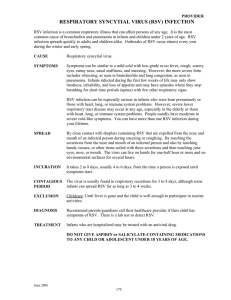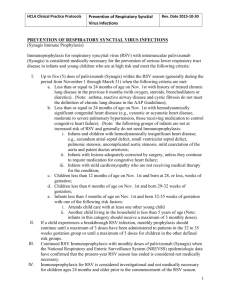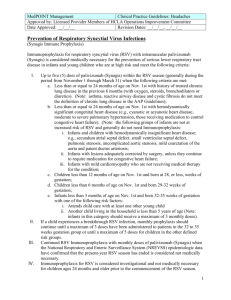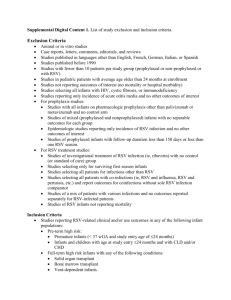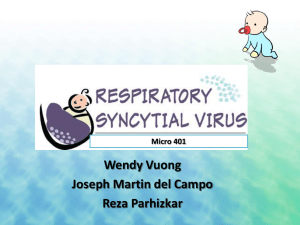Medical and Economic Impact of a Respiratory Syncytial
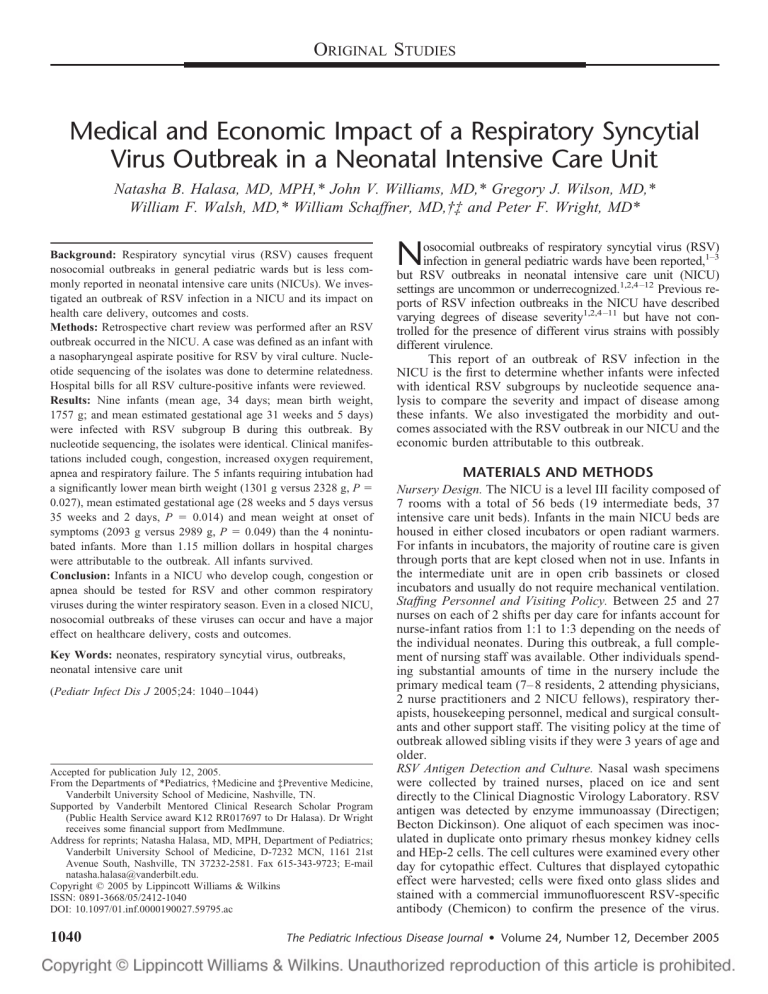
O
RIGINAL
S
TUDIES
Medical and Economic Impact of a Respiratory Syncytial
Virus Outbreak in a Neonatal Intensive Care Unit
Natasha B. Halasa, MD, MPH,* John V. Williams, MD,* Gregory J. Wilson, MD,*
William F. Walsh, MD,* William Schaffner, MD,†‡ and Peter F. Wright, MD*
Background: Respiratory syncytial virus (RSV) causes frequent nosocomial outbreaks in general pediatric wards but is less commonly reported in neonatal intensive care units (NICUs). We investigated an outbreak of RSV infection in a NICU and its impact on health care delivery, outcomes and costs.
Methods: Retrospective chart review was performed after an RSV outbreak occurred in the NICU. A case was defined as an infant with a nasopharyngeal aspirate positive for RSV by viral culture. Nucleotide sequencing of the isolates was done to determine relatedness.
Hospital bills for all RSV culture-positive infants were reviewed.
Results: Nine infants (mean age, 34 days; mean birth weight,
1757 g; and mean estimated gestational age 31 weeks and 5 days) were infected with RSV subgroup B during this outbreak. By nucleotide sequencing, the isolates were identical. Clinical manifestations included cough, congestion, increased oxygen requirement, apnea and respiratory failure. The 5 infants requiring intubation had a significantly lower mean birth weight (1301 g versus 2328 g, P ⫽
0.027), mean estimated gestational age (28 weeks and 5 days versus
35 weeks and 2 days, P
⫽
0.014) and mean weight at onset of symptoms (2093 g versus 2989 g, P
⫽
0.049) than the 4 nonintubated infants. More than 1.15 million dollars in hospital charges were attributable to the outbreak. All infants survived.
Conclusion: Infants in a NICU who develop cough, congestion or apnea should be tested for RSV and other common respiratory viruses during the winter respiratory season. Even in a closed NICU, nosocomial outbreaks of these viruses can occur and have a major effect on healthcare delivery, costs and outcomes.
Key Words: neonates, respiratory syncytial virus, outbreaks, neonatal intensive care unit
( Pediatr Infect Dis J 2005;24: 1040 –1044)
Accepted for publication July 12, 2005.
From the Departments of *Pediatrics, †Medicine and ‡Preventive Medicine,
Vanderbilt University School of Medicine, Nashville, TN.
Supported by Vanderbilt Mentored Clinical Research Scholar Program
(Public Health Service award K12 RR017697 to Dr Halasa). Dr Wright receives some financial support from MedImmune.
Address for reprints; Natasha Halasa, MD, MPH, Department of Pediatrics;
Vanderbilt University School of Medicine, D-7232 MCN, 1161 21st
Avenue South, Nashville, TN 37232-2581. Fax 615-343-9723; E-mail natasha.halasa@vanderbilt.edu.
Copyright © 2005 by Lippincott Williams & Wilkins
ISSN: 0891-3668/05/2412-1040
DOI: 10.1097/01.inf.0000190027.59795.ac
1040
N osocomial outbreaks of respiratory syncytial virus (RSV) infection in general pediatric wards have been reported, 1–3 but RSV outbreaks in neonatal intensive care unit (NICU) settings are uncommon or underrecognized.
1,2,4 –12 Previous reports of RSV infection outbreaks in the NICU have described varying degrees of disease severity 1,2,4 –11 but have not controlled for the presence of different virus strains with possibly different virulence.
This report of an outbreak of RSV infection in the
NICU is the first to determine whether infants were infected with identical RSV subgroups by nucleotide sequence analysis to compare the severity and impact of disease among these infants. We also investigated the morbidity and outcomes associated with the RSV outbreak in our NICU and the economic burden attributable to this outbreak.
MATERIALS AND METHODS
Nursery Design.
The NICU is a level III facility composed of
7 rooms with a total of 56 beds (19 intermediate beds, 37 intensive care unit beds). Infants in the main NICU beds are housed in either closed incubators or open radiant warmers.
For infants in incubators, the majority of routine care is given through ports that are kept closed when not in use. Infants in the intermediate unit are in open crib bassinets or closed incubators and usually do not require mechanical ventilation.
Staffing Personnel and Visiting Policy.
Between 25 and 27 nurses on each of 2 shifts per day care for infants account for nurse-infant ratios from 1:1 to 1:3 depending on the needs of the individual neonates. During this outbreak, a full complement of nursing staff was available. Other individuals spending substantial amounts of time in the nursery include the primary medical team (7– 8 residents, 2 attending physicians,
2 nurse practitioners and 2 NICU fellows), respiratory therapists, housekeeping personnel, medical and surgical consultants and other support staff. The visiting policy at the time of outbreak allowed sibling visits if they were 3 years of age and older.
RSV Antigen Detection and Culture.
Nasal wash specimens were collected by trained nurses, placed on ice and sent directly to the Clinical Diagnostic Virology Laboratory. RSV antigen was detected by enzyme immunoassay (Directigen;
Becton Dickinson). One aliquot of each specimen was inoculated in duplicate onto primary rhesus monkey kidney cells and HEp-2 cells. The cell cultures were examined every other day for cytopathic effect. Cultures that displayed cytopathic effect were harvested; cells were fixed onto glass slides and stained with a commercial immunofluorescent RSV-specific antibody (Chemicon) to confirm the presence of the virus.
The Pediatric Infectious Disease Journal • Volume 24, Number 12, December 2005
The Pediatric Infectious Disease Journal • Volume 24, Number 12, December 2005 RSV Outbreak in NICU
Isolates were subgrouped with an immunofluorescent assay with subtype-specific monoclonal antibodies (Chemicon).
Aliquots of each culture positive for RSV were frozen at
⫺
70°C for subsequent genetic sequencing.
Sequence Analysis.
RNA was extracted from culture supernatants with a commercial kit (QIAMP Viral RNA; Qiagen).
Reverse transcription-polymerase chain reaction were performed with a single tube reaction (Omniscript RT-PCR;
Qiagen). Primers amplified a 219-nucleotide fragment of the nucleocapsid ( N ) gene of RSV which was previously used for phylogenetic analysis of multiple field strains of RSV.
13
Polymerase chain reaction products were cloned into a commercial vector (pGEM; Promega), and the sequence of both strands was determined on an ABI 377 instrument in the
DNA Sequencing Core. Sequences were aligned according to
ClustalW alignment in the MacVector package (Accelrys).
Clinical Data Collection.
A case was defined as any infant with a nasopharyngeal aspirate positive for RSV by viral culture who was present in the NICU during the 20 days of investigation from January 27, 2002 (day 1; the date when the index infant became symptomatic) through February 16,
2002 (day 20; 8 days after the last positive RSV culture and day of last aspirate sent to the virology laboratory). All tests positive by RSV antigen detection were confirmed by culture.
A chart review of all RSV-infected infants was done for the following demographic and clinical data: gestational age; date of birth; gender; birth weight; weight at the onset of symptoms; admission and discharge dates; readmission date; estimated gestational age at birth and at onset of symptoms; date of symptom(s) onset; date of RSV antigen and/or culture-positive; oxygen requirement; date of intubation and number of days intubated; fever or temperature instability; cough; apnea; bradycardia; nasal congestion; bacterial cultures obtained, antimicrobials used, comorbid illnesses, location in the nursery and the administration of blood transfusions or surfactant.
Control Measures.
Control measures included: viral screening by RSV antigen tests and culture of all infants in the nursery to identify infected infants; segregating infected neonates in a separate room; contact precautions (gown and gloves) for infected infants; reemphasizing strict hand washing before and after direct infant care; and administration of palivizumab to all infants in the NICU who were not infected with RSV. The visiting policy was changed to allow visits only by those 13 years of age and older. Visitors and staff with respiratory symptoms were not permitted in the NICU.
Because RSV shedding can range from 1 to 21 days, 14 infants who were RSV-positive were separated from noninfected infants for 3 weeks. The NICU was closed to new admissions with the exception of emergencies for 21 days. All new admissions were placed in a room that had not been occupied by infected infants. Infants who developed acute respiratory symptoms but were RSV-negative were also separated from the other infants for 8 days.
Hospital Charges.
Hospital bills for all RSV culture-positive infants were reviewed. Total hospital charges, including physician charges, were calculated before and after the RSV outbreak and RSV-associated illness for each infant. The first day of charges attributed to the outbreak began when the
© 2005 Lippincott Williams & Wilkins infant’s signs of respiratory symptoms were first documented.
All of these infants had been judged to be nearing discharge from the hospital before acquiring RSV infection. For the 2 infants who had been previously discharged, we used the total of their charges for the second hospitalization.
Statistical Analysis.
The Wilcoxon rank sum test was used to compare variables between intubated and nonintubated infants. The data were analyzed using Stata version 7 (Stata,
College Station, TX).
The study was approved by the University Medical
Center Institutional Review Board.
RESULTS
Characteristics of RSV-Infected Infants.
Nine infants in the
NICU (infants A–I) during the 20 days of investigation were infected with RSV. Day 1 of the outbreak was defined as the time the first infant (infant A) developed signs of respiratory disease as documented in his medical chart. It was not until day 9 of the outbreak, however, that RSV and other viral causes were tested for in the NICU. That same day, the results of the rapid antigen test revealed the diagnosis of 2 RSVinfected infants. Meanwhile 2 of the infants who were present in the NICU the first few days of the outbreak had been discharged. These same infants (infants B and G) were later readmitted to the pediatric intensive care unit and pediatric ward on days 7 and 9, respectively, both with positive RSV cultures. This left 7 of the 9 RSV-infected infants in the
NICU during the remaining 12 days of the investigation.
The mean age of the 9 infected infants was 34 days with a mean birth weight of 1757 g, a mean estimated gestational age (EGA) of 31 5/8 weeks, a mean weight at onset of symptoms of 2491 g and a mean EGA at onset of symptoms of 37 weeks (Table 1). Five of the infants were female. Seven of the infants were white, 1 was black and 1 was Hispanic.
Severity of symptoms ranged from cough and congestion to increased oxygen requirement, apnea and respiratory failure (Table 1). No infant had fever, but 2 infants had temperature instability. The 5 infants requiring intubation had a significantly lower mean birth weight (1301 g versus
2328 g, P
⫽
0.027), mean EGA (28 5/7 versus 35 2/7 weeks,
P
⫽
0.014) and mean weight at onset of symptoms (2093 g versus 2989 g, P
⫽
0.049) than the 4 nonintubated infants
(Table 2). No statistical difference in mean age or EGA at onset of symptoms between the intubated and nonintubated groups was noted. All of the RSV-infected infants survived.
The mean number of days on the ventilator was 12.2
days (range, 2–20). The most severely affected infant (infant
C) required extracorporeal membrane oxygenation (ECMO) for 9 days. Three of the intubated infants and 2 of the nonintubated infants had blood transfusions before the outbreak. Two of the intubated and 1 of the nonintubated infants had a single dose of surfactant before the outbreak. Blood cultures for bacterial pathogens were negative for all infants during their RSV-associated illness.
Seven of the infants tested positive for RSV by antigen detection and viral cultures, and 2 infants had positive viral cultures only. All RSV isolates were subgroup B. Nucleotide sequence analysis of the N gene of all 9 viral isolates revealed
1041
Halasa et al The Pediatric Infectious Disease Journal • Volume 24, Number 12, December 2005
TABLE 1.
Characteristics of the 9 RSV-Infected Infants
Infants
Birth
Weight
(g)
Estimated
Gestational
Age at
Birth (wk)
Infant A 1805
Infant B* 1165
Infant C 940
30 3/7
28
27 3/7
Weight at
Onset of
Symptoms
(g)
2700
2300
2300
Age at
Onset of
Symptoms
(d)
44
53
69
Estimated
Gestational
Age at
Onset of
Symptoms
36 5/7
35 4/7
37 2/7
Apnea Cough
Yes
Yes
Yes
No
Yes
No
Infant D
Infant E
1310
1285
28
29 4/7
1290
1875
Infant F
Infant G †
Infant H
Infant I
Mean
3094
2440
1705
2073
1757
36 5/7
32 3/7
35 6/7
36 2/7
31 5/8
*Readmitted to pediatric intensive care unit.
†
Readmitted to pediatric wards.
CLD indicates chronic lung disease.
4200
2500
2367
2891
2491
11
33
31
17
24
27
34
29 4/7
34 2/7
41 1/7
34 5/7
39 2/7
40
36 1/2
Yes
Yes
Yes
Yes
No
Yes
No
No
Yes
Yes
Yes
Yes
Day of Life to Room
Air After
Birth
24
5
Weaned to
50 mL/min
5
5
0
0
0
6
Oxygen
Needed/d
Intubated
Associated Illness
Besides Prematurity
Yes/10
Yes/2
Yes/16
Yes/20
Yes/13
No
Yes
Yes
Yes
Apnea and bradycardia
Apnea and bradycardia
CLD (required ECMO), apnea and bradycardia
Apnea and bradycardia
Twin, apnea and bradycardia
Jejunal atresia
None
Gastroschisis
Gastroschisis they were genetically identical. No other viruses were isolated by culture.
All infants infected with RSV were in open bassinets and had been deemed clinically stable before RSV infection.
All of the infants, except infant C, were on room air before
RSV infection. Infant C was a 69-day-old former 27-week premature infant with chronic lung disease receiving 50 mL/min oxygen with the intention of being discharged home soon. All infants had been located in the same room near each other’s bassinets at some point during the outbreak.
Control Measures.
It was not until day 9 of the outbreak that the first 2 infants (A and F) were identified with RSV infection. The following infants were then identified on day
10 (infant C), day 11 (infants D, H and I) and day 14 (infant
E) by either a positive rapid antigen test confirmed by culture or a positive culture only. As part of the inpatient screening of all infants, a total of 87 nasopharyngeal aspirates for viral culture from 56 infants remaining in NICU were obtained during days 9 –20 of the outbreak. No new RSV cases were identified during days 15–20 of the outbreak. All infected or symptomatic infants were separated from noninfected infants
TABLE 2.
Comparisons of Intubated and Nonintubated
RSV-Infected Infants
Clinical Feature or Intervention
Mean birth wt (g)
Mean estimated gestational age (wk)
Mean wt at onset of symptoms (g)
Mean estimated gestational age at onset of symptoms (wk)
Mean age at onset of symptoms (d)
Apnea
Cough
Blood transfusions
Surfactant
Intubated
Infants (5)
Nonintubated
Infants (4)
1301
28 5/7
2328
35 2/7
P
0.027
0.014
2093
34 2/3
42
5/5
1/5
3/5
2/5
2989
38 7/9
24.75
3/4
4/4
2/4
1/4
0.049
0.086
0.142
0.264
0.024
0.777
0.655
1042 into the small intermediate or intermediate room during the outbreak. In addition to viral culture and rapid antigen surveillance, the remaining 49 infants also received palivizumab.
No health care personnel were symptomatic, and none were tested for RSV.
Charges Associated with RSV Infection.
Hospital charges related to the RSV outbreak totaled more than 1.15 million dollars. The majority of the charges (94%) were from the 5 intubated infants. For the intubated infants, the RSV-associated illness represented 34% of their total hospital charges. In addition to hospital charges, other expenses included: closure of the NICU to incoming admissions and diversion of infants to other regional NICUs; surveillance viral cultures (73 cultures for a total of $20,075) and RSV rapid antigen tests (87 tests for a total of $11,832) that were obtained from all infants in the NICU; as well as the administration of prophylactic palivizumab to the other 49 exposed infants in the NICU
($131,609, based on a 1-time 15 mg/kg dose per infant). Thus the minimum total health care charges directly attributable to the RSV outbreak were
⬎
1.3 million dollars.
DISCUSSION
In this study, we describe the economic and medical impact of a nosocomial RSV outbreak that generated
⬎
1 million dollars in charges and prompted immediate infection control measures after the discovery of 2 RSV-infected infants in the NICU. After recognition, the attack rate of RSV infants decreased, curtailing further spread. Five of the 9 infants, who had been clinically stable from a respiratory standpoint, required intubation during their RSV infection.
We found that low birth weight, lower current weight and younger EGA were risk factors significantly associated with the need for intubation when compared with infants who were not intubated. We were able to compare risk factors associated with morbidity in these neonates because they were all infected with the same RSV strain, as determined by nucleotide sequence analysis. In addition, no other viruses were isolated by culture. This was particularly important in linking
© 2005 Lippincott Williams & Wilkins
The Pediatric Infectious Disease Journal • Volume 24, Number 12, December 2005 RSV Outbreak in NICU the discharged children who were subsequently readmitted to the pediatric wards to the outbreak and in eliminating confounding factors such as differences in virulence between different RSV subgroups (A and B) or strains. This is the first published study to address this variable.
Infants who are born prematurely, without any other risk factors, are at increased risk for more severe disease when infected with RSV.
15–17
The severity increases if infants have chronic lung disease or congenital heart disease.
18
All 5 of the RSV-infected infants who were intubated had been born at
⬍
31 weeks of gestation. Infant C, the 69-day old former 27-week premature infant with chronic lung disease, was the most severely infected infant requiring ECMO. Three infants had been weaned to room air by day of life 5 and 1 by day of life 24; thus prematurity was their only risk factor. The increased severity of illness that we found in these premature infants may be related to the lack of transfer of maternal antibodies, which play a role in protection
9,12,19 –21.
Furthermore the production of antibody directed at the protective antigens for RSV was lower in premature than in full term infants.
21
Other factors that contribute to increased severity in premature infants included incomplete development of the airway, damage to the airway and airway hyperreactivity.
18
Some studies have reported more severe disease and more frequent isolation of subgroup A than subgroup B strains in hospitalized infants, ported the converse
24
22,23 whereas others have reor did not detect a difference.
25,26
Thus it has been proposed that the severity of infection is more influenced by RSV genotype than subgroup.
26,27 Several studies have suggested that group B strains do not grow as readily in tissue culture as group A and therefore may be underrepresented when comparing frequency of isolation.
28
All of the infants in our study were infected with the same subgroup B strain, with 5 of 9 requiring intubation and 1 of the infants requiring ECMO support. These findings support the observation that RSV subgroup B can be associated with severe disease.
Similar to other reported outbreaks, there was a delay (9 days after onset of signs of respiratory disease) in suspecting
RSV in the NICU.
12
Several reasons for this delay can be proposed. Neonates infected with RSV present with nonspecific symptoms such as apnea, bradycardia and an increased oxygen requirement, which can mimic many other illnesses including bacterial infections.
29 –31
All of these infants were inborn or transferred from an outside hospital at birth, which lowered suspicion for a community-derived viral illness. The onset of cough, which is unusual in a NICU setting, prompted appropriate tests to diagnose a viral respiratory infection. We hypothesize that RSV was easily spread among these infants during days
0 – 8 of the outbreak because the patients were all in open basinets, close by each other, and contact precautions were not instituted. Once the RSV outbreak was identified on day 9, however, infection control procedures were implemented immediately, and no new infants were infected after day 14 of the outbreak. Although health care workers were not screened for asymptomatic infection with RSV, the institution of strict contact precautions would likely have prevented nosocomial transmission from asymptomatic personnel.
© 2005 Lippincott Williams & Wilkins
In each of the 2 seasons since the outbreak we describe,
RSV has been detected in the NICU, but with heightened awareness it was recognized early and no more than 3 cases occurred. Because of repeated yearly infections, we speculate that introduction of RSV in the NICU may be underrecognized and that widespread awareness and testing for RSV and other respiratory viruses are needed during peak respiratory seasons. Careful screening of staff and visitors, particularly children, for respiratory symptoms before entry into the nursery is another critical infection control measure. It was speculated, but not proved, that the introduction of RSV in the outbreak we describe was from a sibling of infant A.
Routine infection control policies in the NICU including strict hand washing, individual patient equipment such as stethoscopes and exclusion of visitors with respiratory symptoms are generally adequate. However, the institution of more stringent contact precautions as described was critical in interrupting the transmission of RSV. Hence we believe the key to outbreak control is early detection of RSV and strict infection control.
There are limitations to our study. Although a thorough effort was made to track all infants who were discharged from the NICU during the 20 days of investigation, we may have missed a former nursery baby who was admitted to a local hospital other than Vanderbilt. This is unlikely as there is close communication and feedback from other hospitals about recently discharged NICU patients, and
⬎
95% of children in the region are admitted to Vanderbilt Children’s
Hospital.
32 The sample size was relatively small and might not have been able to detect differences in mean EGA at the onset of symptoms or other risk factors that might contribute to the severity of disease. Although no other viruses were isolated by viral culture or detected by rapid antigen for influenza, some of the infants could have been infected with other viral pathogens that are not easily detected by culture.
The RSV outbreak had a major impact on the health care-associated financial burden and resource utilization. All of the infants were considered stable from a respiratory standpoint and were close to discharge from the hospital before acquiring RSV infection. The ongoing care required by the RSV outbreak, particularly the 5 infants who required intubation, resulted in
⬎
1 million dollars of additional hospital charges. This emphasizes that nosocomial RSV outbreaks, especially in a NICU setting, have both medical and financial consequences. Early detection of nosocomial RSV outbreaks and institution of strict infection control measures could significantly alleviate these costs. Even though palivizumab was used, there is no evidence to support its use in an outbreak, and further studies of the role of immunoprophylaxis in nosocomial RSV outbreaks are warranted.
During peak RSV season, even neonates who have never left the hospital who experience cough, congestion or apnea should be screened for RSV and other common respiratory viruses. Extremely premature and lower birth weight infants are at highest risk regardless of their current postnatal age. Once a case is identified, it is important to screen all infants in the NICU, separate all symptomatic and infected infants and impose strict infection control measures.
1043
Halasa et al The Pediatric Infectious Disease Journal • Volume 24, Number 12, December 2005
ACKNOWLEDGMENTS
We thank the NICU staff; infection control nurses;
Wray Estes and the virology laboratory staff; and Sharon
Tollefson and Sandy Yoder for their hard work during the outbreak.
REFERENCES
1. Mlinaric-Galinovic G, Varda-Brkic D. Nosocomial respiratory syncytial virus infections in children’s wards.
Diagn Microbiol Infect Dis . 2000;
37:237–246.
2. Hall CB. The nosocomial spread of respiratory syncytial viral infections.
Annu Rev Med . 1983;34:311–319.
3. Hall CB. Nosocomial viral respiratory infections: perennial weeds on pediatric wards.
Am J Med . 1981;70:670 – 676.
4. Amir J, Wielunsky E, Zelikovic I, Varsano N, Rannon L, Reisner SH.
Outbreak of respiratory syncytial virus infection in a neonatal intensive care unit.
Isr J Med Sci . 1984;20:1199 –1201.
5. Goldson EJ. A respiratory syncytial virus outbreak in a transitional care nursery.
Am J Dis Child . 1979;133:1280 –1282.
6. Gouyon JB, Pothier P, Guignier F, et al. Outbreak of respiratory syncytial virus in France.
Eur J Clin Microbiol . 1985;4:415– 416.
7. Hall CB. Respiratory syncytial virus: its transmission in the hospital environment.
Yale J Biol Med . 1982;55:219 –223.
8. Kilani RA. Respiratory syncytial virus (RSV) outbreak in the NICU: description of eight cases.
J Trop Pediatr . 2002;48:118 –122.
9. Wilson CW, Stevenson DK, Arvin AM. A concurrent epidemic of respiratory synctial virus and echovirus 7 infections in an intensive care nursery.
Pediatr Infect Dis J . 1989;8:24 –29.
10. Valenti WM, Clarke TA, Hall CB, Menegus MA, Shapiro DL. Concurrent outbreaks of rhinovirus and respiratory syncytial virus in an intensive care nursery: epidemiology and associated risk factors.
J Pediatr . 1982;100:722–726.
11. Tsolia MN, Kafetzis D, Danelatou K, et al. Epidemiology of respiratory syncytial virus bronchiolitis in hospitalized infants in Greece.
Eur J
Epidemiol . 2003;18:55– 61.
12. Wilson CW, Stevenson DK, Arvin AM. A concurrent epidemic of respiratory syncytial virus and echovirus 7 infections in an intensive care nursery.
Pediatr Infect Dis J . 1989;8:24 –29.
13. Cane PA, Pringle CR. Respiratory syncytial virus heterogeneity during an epidemic: analysis by limited nucleotide sequencing ( SH gene) and restriction mapping ( N gene).
J Gen Virol . 1991;72(pt 2):349 –357.
14. Hall CB, Douglas RG Jr, Geiman JM. Respiratory syncytial virus infections in infants: quantitation and duration of shedding.
J Pediatr .
1976;89:11–15.
15. Boyce TG, Mellen BG, Mitchel EF Jr, Wright PF, Griffin MR. Rates of hospitalization for respiratory syncytial virus infection among children in medicaid.
J Pediatr . 2000;137:865– 870.
16. Meissner HC. Selected populations at increased risk from respiratory syncytial virus infection.
Pediatr Infect Dis J.
2003;22(suppl):S40 –S44; discussion S4 –S5.
17. Stevens TP, Sinkin RA, Hall CB, Maniscalco WM, McConnochie KM.
Respiratory syncytial virus and premature infants born at 32 weeks’ gestation or earlier: hospitalization and economic implications of prophylaxis.
Arch Pediatr Adolesc Med . 2000;154:55– 61.
18. Welliver RC. Review of epidemiology and clinical risk factors for severe respiratory syncytial virus (RSV) infection.
J Pediatr.
2003;143(suppl):
S112–S117.
19. Englund JA. Passive protection against respiratory syncytial virus disease in infants: the role of maternal antibody.
Pediatr Infect Dis J .
1994;13:449 – 453.
20. Crowe JE Jr. Influence of maternal antibodies on neonatal immunization against respiratory viruses.
Clin Infect Dis.
2001;33:1720 –1727. Epub
October 5, 2001.
21. de Sierra TM, Kumar ML, Wasser TE, Murphy BR, Subbarao EK.
Respiratory syncytial virus-specific immunoglobulins in preterm infants.
J Pediatr . 1993;122(5 pt 1):787–791.
22. Hall CB, Walsh EE, Schnabel KC, et al. Occurrence of groups A and B of respiratory syncytial virus over 15 years: associated epidemiologic and clinical characteristics in hospitalized and ambulatory children.
J Infect Dis . 1990;162:1283–1290.
23. Walsh EE, McConnochie KM, Long CE, Hall CB. Severity of respiratory syncytial virus infection is related to virus strain.
J Infect Dis .
1997;175:814 – 820.
24. Straliotto SM, Roitman B, Lima JB, Fischer GB, Siqueira MM.
Respiratory syncytial virus (RSV) bronchiolitis: comparative study of
RSV groups A and B infected children.
Rev Soc Bras Med Trop .
1994;27:1– 4.
25. McIntosh ED, De Silva LM, Oates RK. Clinical severity of respiratory syncytial virus group A and B infection in Sydney, Australia.
Pediatr
Infect Dis J . 1993;12:815– 819.
26. Martinello RA, Chen MD, Weibel C, Kahn JS. Correlation between respiratory syncytial virus genotype and severity of illness.
J Infect Dis .
2002;186:839 – 842.
27. Fletcher JN, Smyth RL, Thomas HM, Ashby D, Hart CA. Respiratory syncytial virus genotypes and disease severity among children in hospital.
Arch Dis Child . 1997;77:508 –511.
28. Hierholzer JC, Tannock GA, Hierholzer CM, et al. Subgrouping of respiratory syncytial virus strains from Australia and Papua New Guinea by biological and antigenic characteristics.
Arch Virol . 1994;136:133–
147.
29. White MP, Mackie PL. Respiratory syncytial virus infection in special care nursery.
Lancet . 1990;335:979.
30. Forster J, Schumacher RF. The clinical picture presented by premature neonates infected with the respiratory syncytial virus.
Eur J Pediatr .
1995;154:901–905.
31. Hall CB, Kopelman AE, Douglas GR, Geiman JM, Meagher MP.
Neonatal respiratory synctial virus infection.
N Engl J Med . 1979;300:
393–396.
32. Iwane MK, Edwards KM, Szilagyi PG, et al. Population-based surveillance for hospitalizations associated with respiratory syncytial virus, influenza virus, and parainfluenza viruses among young children.
Pediatrics . 2004;113:1758 –1764.
1044
© 2005 Lippincott Williams & Wilkins
